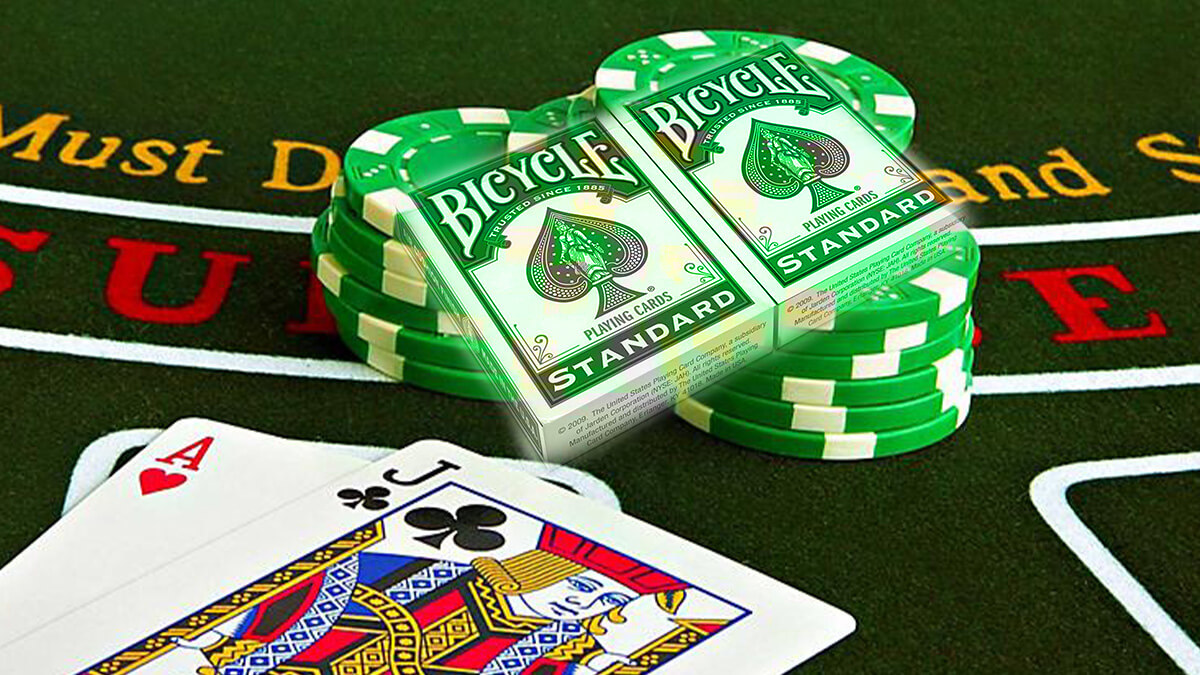Most people already know that if you have the same rules for two blackjack games, you should play the game with fewer decks. The rule of thumb is that, everything else being equal, more decks means a bigger edge for the house.
If you look at the difference between a blackjack game with eight decks dealt from a shoe and a single deck blackjack game with the same rules, you’ll see a difference of almost 0.6% in the house edge. When you’re dealing with a game where you hope to keep the house edge well under 1%, 0.6% is a huge difference indeed.
An eight-deck game even has a 0.3% edge difference from a two-deck game. Of course, most of the time, a casino will have other rules changes to accompany the difference in decks to get the house edge for the game closer to where they want it.
The Number of Decks Has a Big Effect on House Edge and Basic Strategy
It might not seem like the number of decks would make much of a difference, though. After all, what’s the difference between having a deck with four out of 52 cards that are aces and a deck with 32 cards out of 416 that are aces? You still have a 1/13 probability of getting an ace.
The difference is that when you remove a card from the deck in a single deck game, it has a bigger effect than it would in a multiple deck game.
Remove an ace from a single deck and the probability of getting an ace is now 3/51, or 1/17.
Remove that ace from a pack consisting of eight decks, and you still have 31 cards out of 415 that are aces. The probability of getting an ace is about 1 in 13.8.
Here are some other things to consider when thinking about basic blackjack strategy in single deck versus multiple deck blackjack games.
You’ll Get a Natural Less Often When Playing With Multiple Decks
A natural is a big deal in blackjack; in fact, the game is named after the other word for natural. That’s because a blackjack pays off at 3 to 2 odds. This single rule is the main reason blackjack is such a great game for the player mathematically.
In a single deck game, you’ll see a natural about once out of every 20 or 21 hands on average. How do we come up with that number?
You have a 1/13 probability of getting an ace as your first card, so you need a 10 as your next card to make the blackjack. You have 16 cards worth 10 left in a 51-card deck, giving you a probability of getting a 10 of 16/51.
The probability of getting an ace AND a 10 is just the product of those two probabilities. (In other words, you multiply them.) This means that the probability is 1/13 X 16/51, or 16/663.
But that’s not the only way to get a blackjack. You could also get a 10 as your first card and an ace as your second card, so you add the probability of that to the probability of getting an ace and a 10.
This means your probability of getting a blackjack is 16/663 + 16/663, or 32/663. That’s about a 1 in 20.7 probability of getting a blackjack. You can use the same formula when calculating the probability of getting a blackjack from an 8-deck game.
The probability of getting an ace as your first card is still 1/13, but the probability of getting a 10 as your second card is now 128/511.
1/13 X 128/511 = 128/6643
Double that to account for the probability of getting those hands in the other order, and you have 256/6643, which is about the same as about a 1 in 26 probability of getting a blackjack.
If you’re more comfortable with percentages, you’re looking at a percentage chance of getting a blackjack in a single deck game of about 4.8% (in the single deck game) versus 3.8% (in the eight-deck game).
The Dealer Will Get a Blackjack More Often With Multiple Decks
Another thing you account for when thinking about blackjack is the probability that the dealer will also get a blackjack. If you and the dealer both get a blackjack, you have a push instead of a 3 to 2 payout.
How do you calculate that probability?
In a single deck game, the dealer will get an ace as her first card 3/50 times. (Notice how the numbers change to reflect the cards that have already been dealt.) She’ll get a 10 as her second card 15/49 of the time.
So, now you’re looking at 3/50 x 15/49, which is the same as 45/2450. Double that to account for maybe getting the blackjack in the opposite order, and you’re looking at approximately 90/2450. That’s about the same as 1 in 27.2, or 3.67%.
But remember what we discussed earlier in this post and what we demonstrated in the last subsection. When you have more decks, the effects of the removed cards are diluted. The denominators in these fractions don’t change as much.
So, the probability of the dealer also getting a blackjack and winding up with a push happens about 1 in 22 hands instead of just once out of every 27 hands. I won’t bore you by doing the math again because you’ve seen enough examples now that you can calculate that for yourself.
Doubling Down Doesn’t Work as Well With Multiple Decks
These aren’t the only situations that are different in a multi-deck game. Here’s another example:
Suppose your first two cards are a 9 and a 2 for a total of 11. The dealer has a 6 showing. Anyone familiar with basic strategy understands that the right move here is to double down.
Your hope is to get a 10 which will give you an almost unbeatable total of 21.
In a single-deck game, you have 49 cards now unaccounted for, and since none of the cards you see are 10s, you know that the probability of getting a 10 for your next card is 16/49. That’s slightly worse than 1 in 3. Expressed as a percentage, the probability is 32.65%.
In an eight-deck game, though, you have 144 cards worth 10 left in the deck out of a total of 513 cards. That’s a probability of 28.07%. That’s a significant difference.
The problem here isn’t that there aren’t proportionally fewer 10s in the deck. The problem is that there are proportionally more cards worth 9, 2, and 6 left in the deck.
Standing on a Stiff Hand Doesn’t Work as Well With Multiple Decks
A stiff hand is a total of between 12 and 16. These are hands that are unlikely to win unimproved, but they’re also likely to bust if you take another card. Generally, if your dealer’s face-up card is a low card (6 or lower), you’ll stand more often on these totals—hoping that the dealer will bust. If the dealer’s face-up card is a higher card (7 or more), you’ll usually hit.
Standing works well in single deck games when the dealer has a low card because the probability that the dealer has a 10 in the hole is greater. Also, with multiple decks, the probability of her getting a smaller card is greater because there are proportionally more of them left in the deck.
Since the dealer has to hit more often than the player because of the house rules, the difference in the number of smaller cards is better for the casino.
Counting Cards Doesn’t Work as Well in a Multiple Deck Game
Counting cards works because you’re tracking the proportion of aces and 10s in the deck versus the smaller cards. In a single deck game, for example, if you’ve seen 4 aces dealt, you know that the probability of getting a blackjack just dropped to 0.
But, in an eight-deck game, seeing four aces get dealt means that the probability of getting a blackjack has gotten lower, but it’s a far cry from 0. After all, in an eight-deck game, you start with 32 aces in the deck, so you still have 28 aces left in the deck after seeing those four aces get dealt.
For this reason, skilled card counters usually convert their running count into a true count. That’s done by estimating the number of decks left in the shoe and dividing the running count by that number.
For Example:
If you estimate that there are four decks left in the deck, and the count is +4, you divide the +4 by the 4 decks to get a true count of +1.
You’ll make different decisions with a count of +1 than you will with a count of +4. For one thing, you won’t bet as much. It also has basic strategy implications.
Conclusion
If you were wondering why basic strategy changes based on the number of decks in play, you should be clearer on the subject now. This is also the reason why the house edge goes up so much when you put more decks of cards into the game.
It all boils down to getting fewer blackjack with more ties when you do get a blackjack. It also boils down to not getting as much of a boost from doubling down and from the dealer busting less often when you have a stiff hand.
I’m indebted to the America Mensa Guide to Casino Gambling for the inspiration and analysis found in this post. If you haven’t read it, you can find a used copy cheap at any number of websites. It’s out of date in some respects because it was written 20+ years ago, but I learned how to calculate casino and gambling math from the author’s explanations in that book.
Michael Stevens
Michael Stevens has been researching and writing topics involving the gambling industry for well over a decade now and is considered an expert on all things casino and sports betting. Michael has been writing for GamblingSites.org since early 2016. …



